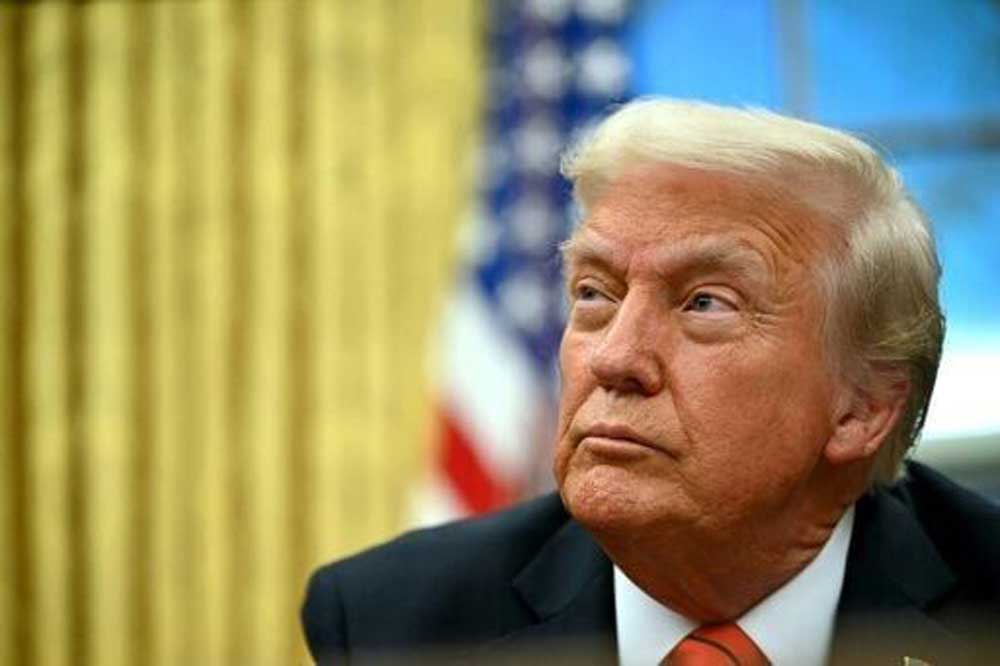How might tariffs impact East Texas? Experts explain.
Published 5:40 am Friday, February 14, 2025

- Since he entered US politics in 2015, Donald Trump has used nostalgia as a powerful electoral tool
East Texas businesses may face price hikes as tariffs on some imports loom, but understanding their purposes can help explain the bigger picture.
“As a strategy it will be good, because you add some pressure, you know that you lose, but you know that they lose more,” said Manuel Reyes, UT Tyler’s Hibbs Institute for Business and Economic Research director. “In terms of economics, strictly speaking, it is bad for all.”
Trending
Strategic use of tariffs
Tariffs, or taxes on imports, are imposed to counteract unfair trade practices from other countries, protect domestic industries or generate revenue. Strategically, they open up trade negotiations, applying pressure on international trade partners to weigh their options carefully.
According to the White House, the flow of drugs like fentanyl through illegal networks has become a national emergency and public health crisis. In response, tariffs on imports from Canada, Mexico and China were proposed to hold these countries accountable for addressing illegal immigration and curbing the drug trade.
China has failed to stop the flow of precursor chemicals to cartels, and Mexican drug trafficking organizations maintain an alliance with the Mexican government, contributing to the overdose deaths of thousands of Americans and threatening national security.
Additionally, Mexican cartels are increasing fentanyl and nitazene, a strong synthetic opioid, production in Canada.
“Access to the American market is a privilege,” the White House website states. “Previous administrations did not fully leverage the U.S.’s position in global trade to advance security, but President [Donald] Trump is taking action.”
Trending
Trade makes up 67% of Canada’s GDP, 73% of Mexico’s GDP and 37% of China’s GDP, but only 24% of the U.S. GDP. Despite this, in 2023, the U.S. had the world’s largest trade deficit in goods, exceeding $1 trillion.
Reyes offered examples to put tariffs into perspective.
Economic pressure
Tariffs can encourage countries to negotiate and reach agreeable terms that benefit all sides.
Reyes said Trump is taking advantage of the importance of trade between the U.S. and Mexico. Trade with the United States is even more crucial for Mexico now, especially with the economic challenges Mexico has faced over the past five to 10 years.
The Mexican economy is shrinking, and now international trade with the U.S. is what sustains it.
Imposing a tariff will hurt the U.S. economy, but the impact on Mexico will be much more severe. This is why the U.S. is pushing for it. While it’s a lose-lose situation, the pressure falls on Mexico, as the economic damage for them will outweigh that of the U.S.
If the U.S. imposes a 25% tariff and Mexico retaliates with its own, it’s not just consumers who will feel the impact — producers will be affected as well.
For instance, the U.S. produces genetically modified corn in the Midwest, essential for making tortillas, a staple in Mexico. At one time, Mexico became less efficient at producing its own corn for tortillas due to advances in genetically modified crops.
As a result, the U.S. exports a significant amount of corn to Mexico to meet demand. This is one example of how retaliatory tariffs could disrupt the supply chain.
Tariffs as protection
Tariffs are imposed to protect local industries and encourage domestic consumption. They help shield domestic businesses from unfair competition by increasing the cost of imported goods, ensuring a more level playing field for local manufacturers.
When a country subsidizes industries — such as China covering electricity costs for manufacturers — businesses can produce goods at lower prices. For example, a subsidized Chinese company might export a calculator to the U.S. for $3, making it cheaper than a similar Texas Instruments calculator priced at $10.
Without tariffs, local companies struggle to compete. To level the playing field, the U.S. government may impose a tariff, raising the imported calculator’s price to $7 or $8. Consumers then choose between a slightly cheaper foreign product or a domestically made one, allowing fair competition for local manufacturers.
This strategy isn’t limited to electronics; it extends to agriculture and other industries as well.
Reyes explained that, a few decades ago, the U.S. produced a large portion of its own oranges, especially in politically significant states like Florida and California, where local growers were key to the economy.
To protect this domestic industry, the U.S. government imposed tariffs on imported oranges.
The goal was to restrict foreign competition, making sure that local growers could maintain their market share and continue selling their products. However, while the intention was to protect domestic farmers, this came at a cost to consumers.
For instance, if the U.S. were to buy orange juice from Central America, where labor costs were much lower, the price would be significantly cheaper compared to sourcing oranges from Florida and California, where labor is more expensive. By imposing tariffs to protect domestic producers, the government essentially made oranges more expensive for American consumers.
In this case, consumers pay higher prices for goods like orange juice because the cost of production in the U.S. is higher than in other countries. While tariffs help domestic industries remain competitive, they often result in higher prices for consumers, Reyes explained.
Tariffs as a revenue source
Governments can use tariffs not only as a protective measure but also as a source of revenue.
When tariffs are imposed on imported goods, the additional cost is typically passed on to consumers in the form of higher prices. The government collects this tariff revenue, which can then be used for public spending, infrastructure or other initiatives.
Tariffs are also a source of revenue for the U.S. government. These payments go directly to the U.S. Treasury and contribute to government revenue.
In 2019, the U.S. generated $71.9 billion in revenue from tariffs. This demonstrates that while tariffs protect industries and jobs, they also bring in significant funds for the government.
Trump once suggested tariff revenue could replace income tax, but implementing such a shift would be difficult, Reyes said. In 2023, the U.S. collected $80 billion in tariff revenue, accounting for 1.8% of total government proceeds.
“It’s not significant,” Reyes said. “Yes, we’re getting some money from these tariffs, but it’s not proportionally, it’s not substantial.”
While tariffs generate revenue, their primary purpose is often to protect domestic industries rather than to serve as a major funding source.
Local impact
While tariffs are good for initiating trade negotiations, if implemented, extra costs don’t disappear; instead, they get passed down the supply chain.
“The ultimate costs of tariffs will be shared by importing firms and consumers based on the degree of price sensitivity,” said Ray Perryman, president and CEO of The Perryman Group.
Costs are split between businesses and consumers depending on buyer sensitivity to price increases. If consumers are willing to pay more (low price sensitivity), businesses will raise prices to cover the tariff costs. If consumers refuse to pay more (high price sensitivity), businesses may have to absorb some of the costs themselves to avoid losing customers.
Companies will raise prices as much as they think they can without driving customers away.
East Texas could see higher costs in several sectors, Perryman explained. Home construction prices may rise due to the large volume of Canadian lumber used in building materials. Energy costs could also climb, as both Mexico and Canada supply steel critical to the industry.
Consumers would feel the impact at the grocery store, with higher prices on food imported from Mexico. Over time, the costs of cars, electronics and other goods from both countries could also increase, putting further strain on East Texas households and businesses.
A retaliatory tariff will make local manufacturers — especially those in machinery and chemicals — less competitive. This could lead to a loss of sales as buyers seek more affordable options elsewhere. To compensate, manufacturers may have to cut jobs, reduce production, or implement cost-saving measures, which could hurt the industry rather than help it.
“It is crucial that agreements on key issues are reached among the North American nations as soon as possible to reduce the effects of sustaining these destructive measures for an extended period,” according to a report by The Perryman Group.
Big picture
When countries engage in international trade it allows them to access goods or services that are either not available domestically or are cheaper to produce elsewhere.
“In every country, we want to buy goods and services from others…because we don’t have those, or it’s more convenient in terms of cost,” Reyes said. “International trade is a win-win.”
For instance, many goods are imported to the United States from countries with lower labor costs, such as those in Central America, Thailand and Singapore. Countries like China, for example, are known for producing wood and other goods at a lower cost due to cheaper labor.
Similarly, the United States imports manufactured goods from countries like Mexico and Canada, where labor costs for things like automobiles or clean manufacturing are more cost-effective compared to domestic production. The primary benefit of international trade is that countries can focus on what they do best and buy what is more expensive to produce themselves.
This system creates a double benefit: consumers get access to goods at lower prices, and countries can invest their resources in industries where they have a comparative advantage.
“As a strategy, it’s good because you’re pushing; it’s a negotiation,” Reyes said. “President Trump is a great negotiator, so as a negotiation tactic, it’s effective because you’re pushing your partners to the edge. But if you’re really planning to follow through, eh.”






